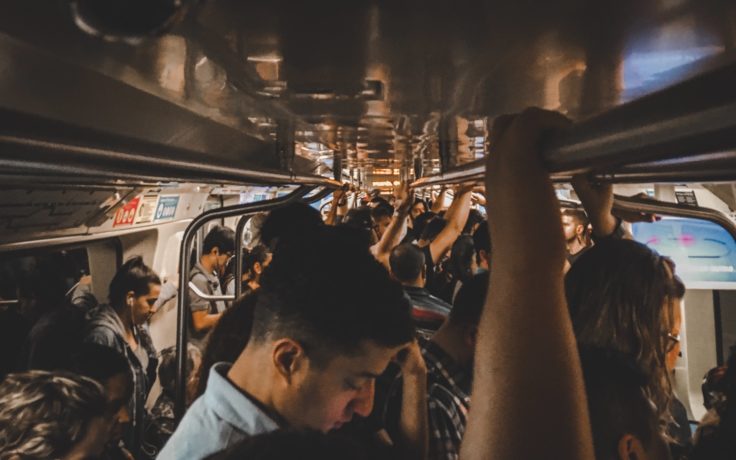September 26, 2022
Ensuring More Equitable, Inclusive Mobility in Brazil and Beyond
The country of Brazil is experiencing a crisis in accessible, affordable transport that has negatively impacted the quality of life of Brazilians for decades.
Investing in better, more sustainable, and higher-quality public transport for the Brazilian population requires acknowledging the country’s systemic social, economic and racial inequalities.
The urban development model that has been promoted in most Brazilian cities has historically concentrated opportunities for employment, culture, and leisure in centrally-located areas where wealthier and predominantly White populations live. This model has also been responsible for rampant urban sprawl that continues to support investment in infrastructure that promotes the use of private vehicles, such as cars and motorcycles. As a direct result, Brazilian cities have had less investment and priority given to sustainable and equitable transport modes – like public transit, walking, and cycling – and created an imbalance in the way that diverse populations live, work, and experience their cities.
Most of the Brazilian population consists of lower-income and Black populations who generally live further far from urban centers, thus placing them further from essential services and opportunities. Transit access to these more peripheral, lower-income neighborhoods is scarce and provided mainly by low-quality infrastructure and informal services, which often do not receive public subsidies. Read more about the intersection of race and mobility in Brazil.
As the most reliant on public transport, low-income Black Brazilians also pay a majority of the costs that keep services like bus systems afloat. With the COVID-19 pandemic, a significant reduction in transit ridership has left transit services even more under-resourced since 2020. Now, more than ever, there is an urgency for local governments and policymakers to find new ways of financing public transport infrastructure to ensure their fiscal sustainability while improving the quality of services and creating more equitable access for all Brazilians.

To explore these pressing issues, ITDP Brazil developed a report entitled “Challenges and Solutions for the Equitable Management of Mobility in Brazil” to highlight equitable mobility management strategies, such as parking reforms and driving restrictions on fuel-burning vehicles, that have already been adopted around the world. The main objective of many of these strategies is to de-incentivize the use of private vehicles and expand sources of revenue for investing in more efficient, accessible, and sustainable modes of urban transport. ITDP Brazil’s report reviews these global strategies in a local context – taking into account Brazil’s history of social, racial, and economic segregation – to critically examine the impact that these policies can have on the country’s mobility systems.
What are examples of mobility management measures?
Examples of management measures currently in use in cities include, but are not limited to:
- parking management
- congestion pricing
- emissions pricing
- pricing based on distance traveled
- pricing based on vehicle occupancy
- charges for vehicle ownership.
These policies seek to discourage car use while potentially providing more revenue for cities to invest into other services and alternative transport modes. The perpetual underfunding of public transport systems around the world, which have been exacerbated further by the decline in ridership and revenue during the pandemic, makes it even more urgent for cities in this current climate to diversify and expand their revenue streams.
Many cities are employing approaches that consist of charging and/or taxing cars and motorcycles first and foremost, and reinvesting the resources in collective and active public transport systems. These measures also serve to increase drivers’ awareness of the impacts of unnecessary car use while opening new channels for funding improvements in other transport modes.
How can mobility management strategies be applied in a Brazilian context?
However, the consequences of replicating such management measures from more developed countries in the context of Brazilian cities warrant further study. It is critical that a broad application of these mobility strategies do not exacerbate existing inequalities, but rather help to address the root causes of systemic inequality and inaccessibility that exist in Brazilian cities.
ITDP Brazil’s report addresses these challenges and presents several successful national examples that demonstrate the feasibility and benefits of employing global mobility management policies with a local context in mind. Drawing from bibliographic surveys, data collection, and targeted indicators, as well as interviews with experts in urban mobility, the report identifies several factors for consideration when its comes to improving mobility management:

THE SPATIAL CONFIGURATION OF CITIES. Since the suburbs of Brazilian cities vary greatly in socioeconomic makeup compared to cities in developed countries, the application of management measures should not be applied uniformly. In Brazil, the implementation of tariff policies applied equally to all vehicles would mainly affect the suburban and peripheral population, which already deals with lack of access and low-quality services.

EXISTING PRIVILEGES. Mobility structures in Brazil guarantee privilege and greater access to wealthy and White populations, who have more options for transport close to their homes in city centers. These groups also have the highest ownership of private vehicles.

GOVERNANCE ISSUES. Political concerns, observed both on a national and municipal scale, can make it difficult to adhere to policies of a redistributive nature in the most diverse areas, contributing to the maintenance of the existing social and economic hierarchy in Brazil.

MONETARY, PHYSICAL AND MENTAL COSTS. The lowest-income populations spend more time on public transport and are responsible for most of the system’s revenue. In addition to the financial issues, transport also causes physical and mental exhaustion during long and hazardous commutes. Measures that increase tariffs for the population with higher incomes can help to correct these disparities.

CAR CULTURE AND LACK OF SUSTAINABLE TRANSPORT OPTIONS. The low supply of reliable, comfortable, flexible, and convenient public transport makes private vehicles the first choice for commuting. In the case of low-income families, using a private vehicle may be the most appealing option to travel, even if acquiring a car is expensive or leads to debt. Considering the few attractive options for the populations living on urban peripheries, pricing uniform strategies can have a negative impact on mobility.

Mobility management measures need to be equitable, preventing them from further limiting the ability of Black and low-income people to be mobile in their own cities.
Given the complex and intersectional issues outlined above, the report presents potential solutions for Brazil’s cities to make urban mobility more just and equitable for all citizens, taking into consideration local factors, with lessons for many other global cities as well.
First and foremost, revenue strategies to finance more sustainable mobility infrastructure needs to ensure that the lower-income people are not additionally burdened with a growth in associated costs. Furthermore, solutions should not be thought of only within the scope of the transport sector, and should extend to other fields of urban development. Among the proposals presented in ITDP Brazil’s report include:

MOBILITY SUBSIDIES, such as the creation of the Single Urban Mobility System (SUM) and the taxation of transport applications.

STIMULATING RIDERSHIP AND INVESTMENT IN PUBLIC TRANSPORT, based on policies related to transport vouchers, balancing investments in public and private transport, and exploring advertising revenue on vehicles.

MANAGING INDIVIDUAL MOTORIZED TRANSPORT based on parking management measures, pricing for the use of road space according to the type of vehicle, and allocating resources from private car tariffs to invest in public transport.
 PROMOTE AND INVEST IN ACTIVE TRANSPORT by integrating with medium and high-capacity transit stations and promoting safe spaces for people to cycle and walk.
PROMOTE AND INVEST IN ACTIVE TRANSPORT by integrating with medium and high-capacity transit stations and promoting safe spaces for people to cycle and walk.
 CREATE NEW CENTRALITIES by developing housing closer to urban opportunities through the strengthening of new city centers beyond the historic areas.
CREATE NEW CENTRALITIES by developing housing closer to urban opportunities through the strengthening of new city centers beyond the historic areas.
 MANAGING LAND PROPERTY IN URBAN AREAS, by applying property and land taxes on commercial establishments and residences differently according to local standards.
MANAGING LAND PROPERTY IN URBAN AREAS, by applying property and land taxes on commercial establishments and residences differently according to local standards.
Successful examples of mobility management strategies across Brazil are detailed in the report, such as rotating parking systems in Fortaleza (Zona Azul Digital) and in São José dos Campos (Zona Azul Eletrônica), and the transportation taxes being applied in São Paulo. These cases help to demonstrate that social and territorial characteristics can be integrated into mobility management strategies based on international best practices, while also being cognizant of the unique aspects of regional cities and cultures.
By examining potential challenges and solutions for equitable mobility, this report offers critical evaluations, ideas, and recommendations for strategies that can be adopted in other developing countries beyond Brazil. Ultimately, it is crucial that any mobility and transport policy being implemented helps to distribute resources and investments to lower-income and less privileged populations. Urban mobility strategies need to ensure that those with wealth and resources pave the way for transport infrastructure improvements that do not place additional burdens on those that have been historically disadvantaged by past policies.
Download the Executive Summary of the report in English here >>
